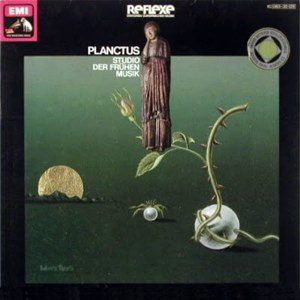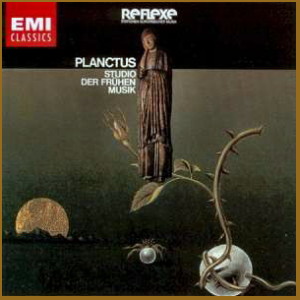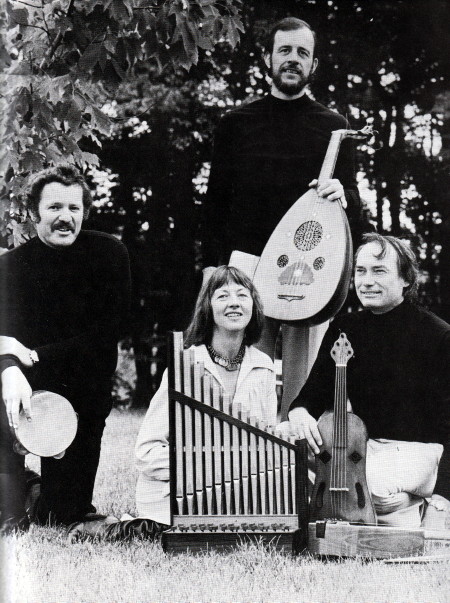 |
1 LP -
1C 063-30 129 - (p) 1976
|

|
| 1 CD - 8
26497 2 - (c) 2000 |
|
| PLANCTUS |
|
|
|
|
|
| Planctus cigne |
|
|
| - Clangam, filii
(Anonym) - Text nach Bruno
Stäblein |
6' 31" |
|
| 4 Planctus from
las Huelgas |
|
|
| - Plange Castilla
(Sancho III) - Text nach Higini
Angles |
3' 45" |
|
| -
Quis dabit (Fernando III?) - Text
nach Higini Angles |
5' 02" |
|
| -
Rex obiit (Alfonso VIII) - Text
nach Higini Angles |
4' 07" |
|
| -
O monialis concio (Fernández de
Agüero) - Text nach Higini
Angles |
6' 07" |
|
|
|
|
| - Ples de tristor
(Guiraut Riquier, um 1150-um 1220) |
12' 33" |
|
| - Fortz chausa es
que tot lo major dan (Gaucelm
Faidit, um 1230-um 1300) |
8' 19" |
|
| - Tristor et cuncti
tristantur (aus der Bordesholmer
Marienklage, um 1476) (Anonym)
- Text nach Friedrich
Gennrich |
4' 24" |
|
|
|
|
| STUDIO DER FRÜHEN
MUSIK / Thomas Binkley, Musikalische
Enrichrung |
|
| -
Andrea von Ramm, Sängerin |
|
| -
Richard Levitt, Sänger |
|
| -
Sterling Jones, Rabel morisco,
Lira und Vielle |
|
| -
Thomas Binkley, Laute und
Chitarra saracenica |
|
| unter
Mitwirkung von |
|
| -
Benjamin Bagby, Sänger |
|
|
|
|
|
Luogo
e data di registrazione |
|
Evangelische
Kirche, Séon (Svizzera) - 24
maggio / 2 giugno 1976
|
|
|
Registrazione: live /
studio |
|
studio |
|
|
Producer / Engineer |
|
Gerd
Berg / Johann-Nikolaus Matthes
|
|
|
Prima Edizione LP |
|
EMI
Electrola "Reflexe" - 1C 063-30
129 - (1 lp) - durata 50' 59" -
(p) 1976 - Analogico |
|
|
Prima Edizione CD |
|
EMI
"Classics" - 8 26497 2 - (1 cd) -
durata 50' 59" - (c) 2000 - ADD |
|
|
Note |
|
- |
|
|
|
|
|
 Planctus means
lament, the expression of
grief and sorrow, regret or
sadness. Planctus, in medieval
times was this expression in
song. The origin and history
of planctus is long and
intertwined with the history
of the lai and the sequence,
Some planctus, such as those
of Peter Abelard (cf 1C 063-30
123) are written on Biblical
themes and are of great
length. The use of the Latin
language separates them from
the vernacular lai. They are
called planctus because the
text presents a tragic
situation. A planctus may be
an allegory (Planctus
Cigne in the present
recording) in which calamity
is inferred. Many planctus are
more personal than these,
being monuments on the death
of real people, usually people
in the political arena. These
planctus, being of a later
date, may be in the vernacular
and may employ ordinary song
structures (Ples de tristor,
Fortz chausa in the
present recording). The
structural difference between
these types is clearly seen in
a comparison of Planctus Cigne
with the later vernacular
planctus. Planctus Cigne
employs the principal of the
lai, in which sections of
differing length (puncta)
are sung one or more times,
always with new text, never to
recur having once been
dropped. Ples
de tristor, onthe other
hand, is a strophic song
concluding with a tornada, a
repeat of the last portion of
the melody. The Latin planctus
from Las Huelgas may be viewed
as strophlc songs with but a
single strophe. Planctus means
lament, the expression of
grief and sorrow, regret or
sadness. Planctus, in medieval
times was this expression in
song. The origin and history
of planctus is long and
intertwined with the history
of the lai and the sequence,
Some planctus, such as those
of Peter Abelard (cf 1C 063-30
123) are written on Biblical
themes and are of great
length. The use of the Latin
language separates them from
the vernacular lai. They are
called planctus because the
text presents a tragic
situation. A planctus may be
an allegory (Planctus
Cigne in the present
recording) in which calamity
is inferred. Many planctus are
more personal than these,
being monuments on the death
of real people, usually people
in the political arena. These
planctus, being of a later
date, may be in the vernacular
and may employ ordinary song
structures (Ples de tristor,
Fortz chausa in the
present recording). The
structural difference between
these types is clearly seen in
a comparison of Planctus Cigne
with the later vernacular
planctus. Planctus Cigne
employs the principal of the
lai, in which sections of
differing length (puncta)
are sung one or more times,
always with new text, never to
recur having once been
dropped. Ples
de tristor, onthe other
hand, is a strophic song
concluding with a tornada, a
repeat of the last portion of
the melody. The Latin planctus
from Las Huelgas may be viewed
as strophlc songs with but a
single strophe.
Planctus Cigne
Planctus
Cigne (the Swan’s
Lament), is perhaps the most
famous of all
planctus, known to modern
listeners through the Carl
Orff Carmina Burana
score. Indeed the original
version is quite different!
This is one of six Carolingian
sequences which have survived
in about two dozen manuscripts
from the 9th to 13th
centuries. Planctus
Cigne underwent many
changes in the course of time,
and new texts were added to
provide a religious
significance to the allegory.
The original text contains the
following story: a swan flies
out from land over the sea,
and encounters a storm. The
swan laments its fate as it is
tossed about in the waves, too
weak to rise above the storm
and unable to catch the many
fish which would give
sustenance. But as morning
breaks, the storm subsides and
the swan regains its strength,
and it is able to fly joyously
back to the land.
Four Planctus from Las
Huelgas
Las Huelgas is the name of a morastery
near Burgos in Old Castile. It was
founded by
Alfonso VIII,
who gained fame especially for
his victory over the Moslems
at the battle of Las Navas de
Tolosa in 1212. Some time
after his death a planctus was
written in his honour, Rex
obiit, which was
assimilated into this large
manuscript. It
was another scribe that
entered Plange Castilla,
a lament on the death of
Alfonso’s father, Sancho III, on
whose death the kingdoms of
Castile and León were
divided between two sons. (It is
interesting to note that the
Spanish kings were connected
to the dominant European
cultural developments: Alfonso
VIII,
for example was married to
Eleanor, daughter of Henry II
(Anjou) of England and Eleanor
of Acquitain, a symbol of the
troubadour culture; Richard
Coeur de Lion was a son of
that union, whose death was
the subject of another
planctus discussed below).
Another Las Huelgas planctus
is Quis dabit capiti meo
aquam, possibly written
onthe death of the grandson of
Alfonso VIII,
Ferdinand, later Saint
Ferdinand (San Fernando). The
final planctus laments the
death of the Abbes of Las
Huelgas, and contains the
inscription De dompna Maria
Gundissalvi de Aguero,
abtissa
et nobilissima
super omnes abbatissas.
This Maria
Gonzàles
was a member of a renowned
family, one of whose members,
Pero Gonzáles
de Aguero was present at the
ceremony prepared by our
Abbess at Las Huelgas two days
before the coronation of the
young Alfonso XI, and
who continued in the service
of Peter “the cruel", son of
Alfonso XI.
Ples
de tristor
(Guiraut Riquier)
Guiraut was born about 1230,
in Narbonne, at that time a
town of business rather than
courtly affairs. His
first song is dated 1254 and
seems to be addressed to the
wife of the Vicecount of
Narbonne. Later, unable to
secure a worthy existence in
the Languedoc after the
ravages of the Albigentian
Crusade (cf. 1C 063-30
132), Riquier went to Spain,
at the court of Alfonso X el
Sabio in Burgos. Here he
remained some ten years,
active as a poet-composer.
Guiraut wrote an epistle 1274
to Alfonso in which he bade
the king to decide upon a
vocabulary for the different
sorts of artists - Guiraut
suggested there be four
categories beginning with the
acrobats and tight-rope
walkers, for which he
suggested the term jongleurs,
while menestrels
would include the musicians
and singers, trobadores
the authors and composers,
while doctores de
trobar would include the
recognized masters (to which
class he certainly ascribed
himself). About 1279 Riquier
left Spain for the protection
of Count Henry II of Rodez,
who still was able to continue
something of the
pre-Albigentian life style.
Guiraut wrote a song book
containing his own
compositions arranged in
chronological order. Two
copies of this book have
survived, one clearly copied
from the original, for it
contains the following
heading: Aissi comensan los
cans d'En Guiraut Riquier
de Narbona,
en aissi cum es de cansos e
de verses e de pastorellas
e de retroenchas e de
descortz e d'albas e
d’autras diversas obras, en
aissi adordenadamens cum era
ordenat en lo sieu libre;
del qual libre escrig
per la
sua man fob aissi tot
transladat; e ditz on aissi
cum de sus se conten.
Unfortunately, the complete
copy (Paris f. fr. 856)
contains no music, however the
shortened copy does contain 48
melodies, among them our
planctus. This planctus bears
the inscription: Planh que
fe Gr. Riquier del senher de
narbona
l'an MCCLXX e es uers
plahn. - written in
other words 1270 on the
death of Amalric IV, Vicecount of
Narbonne.
Fortz
chausa es que tot lo major
dan
(Gaucelm Faidit)
Somewhat younger than Guiraut
Riquier
was Gaucelm Faidit, born in
Uzerche not far from
Ventadorn, the home of Bernart
de Ventadorn (cf. 1C 063-30 118);
in fact, Gaucelm was enamoured
of Maria
de Ventadorn discussed in the
razos. He
was a conservative poet, the
vida says he had a very bad
voice and the Monk of Montaudon
tells us how small his sphere
of influence was - so it is
somewhat surprising that he
should be the author of the
most famous troubadour
planctus, this on the death of
Richard the Lion-hearted.
Richard died, it will be
recalled, 1199 during a minor
struggle with one of his
vassals; Richard’s
insignificant death did not
distract from his significant
life: it was Richard who was a
match for Saladin inthe Outre
Mer,
and his accomplishments there
towards restoring Western
influence were greater than
any other leader, including
his enemy Philip Augustus. It
had been the news in 1187 of
the fall of Jerusalem that
sent him off along with
Frederick Barbarossa and
Philip, and it was in 1190
that he set off, one year
after his coronation as the
English king (for
Faidit he was certainly better
known as the Duke of
Aquitaine).
Tristor et cuncti
tristantur
Tristor et cuncti
tristantur is an excerpt
from the so-called Bordesholm
Lament, which was regularly
performed at the cloister of
Bordesholm (near Kiel in
northern Germany) on Good
Friday or on Monday of Holy
Week. It lasted 2-1/2 hours.
Several of the sections of
this work -
which resembles a Passion or
Passion Play, employ melodies
known to the secular sphere:
the one selected here is that
melody employed by Walther von
der Vogelweide
for his Palaestina song, Nu
aler erst..., a melody
that Walther adopted from the
troubadour song ot Jaufre Rudel,
Lanquan li
jorn.
Concerning the
Interpretation:
More
and more it is the tendency in
the performance of medieval
music to rely somewhat on
instinct where the facts run
out. This ought not to be a
license for unsubstantiated
music-making (although I feel
it often is), but ought be
viewed as a necessary
challenge. One unfortunate
result of this however, is
that it is difficult in the
extreme to keep the listener
informed of the substance of
the musical position, with the
result that much is
misunderstood. What may seem
to the listener a minor sixth
chord may be in reality the
result of the drone strings on
that particular instrument,
and what may seem rambling
improvisation may really be a
detailed expansion of tones
according to a clear
discipline.
So I feel it might be of
interest to the listener to
have pointed out here that the
opening of the Planctus Cigni
is a Lydian scale (transposed)
encompassing the tones of the
melody to come, and followed
by suggestions of subjects
such as a descending fourth as
a swan symbol (from the melody
at the word cigni),
that the accompaniment derives
from musical symbols contained
in the melody, such as the
weaving through three or four
notes in the lament beginning
with line 5, leading to the
resolution at dulcimodo
cantitans and the swan’s
return to land.
Such an approach is not
employed in the four planctus
from Las Huelgas, where
symbolism takes a back seat to
basic musical materials of
mode and imitation, drone and
structure.
Still another approach is
employed in the naive
Bordesholmer planctus, where
it is the tuning of the
instrument, drones plus a
single melody string, that
dictates the tone
combinations.
And
finally the two troubadour
songs are treated as I would
any straight-forward
troubadour songs, connecting
the character of the
instrument with the expression
of the text, by drawing
attention to specific tones
and intervals that I feel are
of particular importance in
the song.
The
instruments employed include
two sorts of medieval lute,
lira, vielle, chitarra
saracenica, rabel, morisco.
Thomas
Binkley
Sources:
- Kiel, Univ.
Bibl. Mscr. 53 4° (Bordesholmer
Marienklage)
- Las Huelgas,
Codex musical (facs. ed. H.
angles)
-
Milano, Bibl. Ambrosiana R
71 sup. (Manuscript G, ed.
Sessini)
-
Paris, B. N. lat. 887
(Limoges, St. Martin)
- Paris,
B. N. n. a. lat. 1084
(Limoges, St. Martin)
-
Paris, B. N. f. fr.
22543
(Manuscript R)
|
|
|
EMI Electrola
"Reflexe"
|
|
|
|

